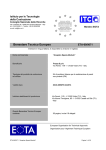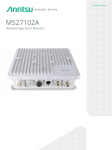Download BEIJING – New gTLD pre-delegation testing Process
Transcript
BEIJING – New gTLD pre-delegation testing Process Review EN BEIJING – New gTLD pre-delegation testing Process Review Wednesday, April 10, 2013 – 11:00 to 12:30 ICANN – Beijing, People’s Republic of China UNIDENTIFIED MALE: We’re now beginning recording and streaming for the new gTLD predelegation testing process review meeting. RUSS WEINSTEIN: Good morning. If everyone could find seats and we can get started in a minute or so here. Please come forward to the table if you plan on speaking, asking questions. Try and make it as intimate a session as we can. Okay, so we’ll go ahead and get started. The session is about predelegation testing and a new acronym we’ve coined, PDT. I’m Russ Weinstein. I’m the ICANN panel coordination manager, responsible for pre-delegation testing. I’m on Christine Willett’s new gTLD operations team and I brought a team here with me to help present pre-delegation testing And everyone introduce themselves. Maybe we can start with Frederick. FREDERICK LJUNGGREN: Sure. I’m Frederick Ljunggren from Kirei. We assist ICANN in developing the requirements for the PDT all based on the Applicant Guidebook of course. Note: The following is the output resulting from transcribing an audio file into a word/text document. Although the transcription is largely accurate, in some cases may be incomplete or inaccurate due to inaudible passages and grammatical corrections. It is posted as an aid to the original audio file, but should not be treated as an authoritative record. BEIJING – New gTLD pre-delegation testing Process Review JACOB SCHLYTER: EN I’m Jacob Schlyter of Kirei, working together with Frederick, assisting ICANN. FRANCISCO ARIAS: Francisco Arias, ICANN technical staff. I (inaudible) for this predelegation testing. MATS DUFBERG: I’m Mats Dufberg of dot-SE. Dot-SE is the PDT service provider. DANNY AERTS: And my name is Danny Aerts from .SE. CHRISTINE WILLETT: And I’m Christine Willett from ICANN. RUSS WEINSTEIN: Great. The goal of this session is to give applicants more information about pre-delegation testing, to help them prepare for pre-delegation testing. Thank you, everyone for coming. We hope this session is beneficial to everyone. So, I’ll walk you through the agenda we have here. I’m going to give an intro, an overview of pre-delegation testing, introduce the process. We know we haven’t revealed that much about the process of predelegation testing before so this is a little bit of unveiling of that. Page 2 of 51 BEIJING – New gTLD pre-delegation testing Process Review EN And then Jacob and Frederick will take us through some of the technical aspects of how to prepare for a successful pre-delegation testing experience. Mats, from the service provider, he will provide some lessons learned from the pre-delegation testing Pilot. For those of you who don’t know, we recently conducted and concluded a PDT Pilot and we consider it a success. We learned a great deal and so we wanted to share what transpired in the pilot and what we learned from it and what we’re doing to make the production even more beneficial and successful to the applicants. At that point we’ll take some time for a Q&A. After a lot of contents presented, we’ll do some Q&A and then if there’s time, we’ll get back into a little bit of tutorial on pre-delegation testing in terms of we’ll give you some preview of what the system looks like that you’ll be interacting with and Mats will take you through that. And I’ll wrap up with some resources and information that are available to you now and what will be coming forth in the coming days. I wanted to give everyone perspective on where we’re at when we talk about pre-delegation testing. When you enter pre-delegation testing, that means you've passed evaluation – the initial evaluation or extended evaluation. You've signed a registry agreement with ICANN and now you're ready for pre-delegation testing. Assuming your system is production-ready, your infrastructure is all production-ready – and my friends here at Kirei will tell you more about what production-ready systems mean in their section. Page 3 of 51 BEIJING – New gTLD pre-delegation testing Process Review EN What is pre-delegation testing? It’s a verification step. It’s to ensure the registry system is ready for production, delegation into the root zone. It’s partially a manual review of documentation as well as system testing to ensure the systems are working as expected, and there’s the five key elements: DNS, WHOIS, EPP, data escrow, and if applicable IDN. All we want to convey here on this slide is that the applicant systems when we tested from all of the nodes and we published where the IP address is from each of those nodes are published in the FAQ document that’s available on the PTD micro-site in the resources section, so you need to prepare your system to accept traffic from those nodes. I want to talk about the process a little bit here like I mentioned. We haven’t talked too much about the process up until this point. So first, there will be preparation activities. Once you've completed a registry agreement with ICANN, you’ll get notification that you're now ready to enter into pre-delegation testing and you can set up a test appointment with ICANN and you can identify pre-delegation point of contact both with ICANN through our CRM tool. We recognize that most of the primary contacts may not be the right person to lead your application through pre-delegation testing. So we wanted to create a delegate, so to speak, someone who’s comfortable and familiar with the registry systems and registry services and the technical infrastructure of your registry so they can lead you through pre-delegation testing successfully. You’ll then – once you have a test appointment established, you’ll be able to submit the input data required into the system in the pre- Page 4 of 51 BEIJING – New gTLD pre-delegation testing Process Review EN delegation system. That needs to be completed before the testing appointment. The testing appointment is expected to be two weeks – a two-week span. But we created a process where you can extend that by a week to allow for any areas to be remedied. We really want to make sure that small things could be corrected in that three week window to allow for more applicants to succeed at pre-delegation testing. We didn’t want to be failing applicants for minor problems with the system or with the connectivity and things, so we created a process where if remedy needs to occur, there’s a time slot in there for remedy to occur. Then ICANN will deliver the results to the primary contact of the applicant. We expect that to take roughly two to three weeks. We’re working to get it as tight as we can. But roughly two to three weeks after the conclusion of your testing window. Like I mentioned, there might be situations where there’s information that needs remedy before all the testing can be completed. So we’ve created a process, follow-up questions. These questions will come to the pre-delegation testing contact through the tool – the messaging tool in the pre-delegation testing system. Primarily we’re seeing two types of questions. There will be questions about the input data, issues with it being complete or fully accurate, and those are slated to be issued by the end of the first week. And then there may be connectivity or minor protocol type of questions that are occurring while the automated tests are trying to be performed and those need to be resolved within the testing window. So to help you guys prepare, you need to have somewhat stand by support. It doesn’t Page 5 of 51 BEIJING – New gTLD pre-delegation testing Process Review EN need to be 24-hour by any means but be able to respond to these questions as quickly as possible to facilitate successful testing. I’ll then pass it over to Jacob and Frederick. I think Frederick was going to kick it off. FREDERICK LJUNGGREN: Thank you, Russ. First slide, please. Thanks. So, “production-ready” what that actually means is that we’re going to prepare the predelegation testing on the actual production system. So the PDT is actually quite comprehensive set of tests. All the tests are published at the PDT micro-site so that you can download them, you can check out exactly what each test is about, the expected outcome of it. So we would really recommend you to take a close look at that and prepare for those tests. Check, check again, test yourself that you will pass PDT smoothly. Next slide, please. The PDT provider requires a set of data from you. It’s basically two parts. One part is technical parameters for performing technical, partly automated tests for DNS, EPP, and WHOIS. The other set of data is the self-certification documentation which you need to prepare. For this, there are templates available and you’ll also find it at the micro-site. There are also examples there which you can use for making sure that the information is complete. JACOB SCHLYTER: The parameters you are (inaudible) are first the technical parameters and we’ve chosen to communicate that using XML and this is mainly because the parameters are usually created by someone maybe not Page 6 of 51 BEIJING – New gTLD pre-delegation testing Process Review EN submitting the parameters themselves. It could be DNS IP addresses. It could be EPP commands with EPP extensions. It could be WHOIS server parameters and such. So those are provider as XML and the schemas are available on the micro-site as well. We urge you to verify all data and verify compliance with the schemas before you submit it. The provider will check the schemas but verify it again anyway to be able to submit smoothly. We have the IDN tables. Part of the application IDN tables were submitted usually as PDF. For the PDT, we would like you to submit the IDN tables in machine readable format, preferably the RC-4290 or 3743. There are cases where those may not be applicable. In such case, you could use another text (based) format and provide some documentation how to parse that format and we would be happy to try to do that for you. But if you can, please use the standard format. Other documentation such as the self-certification, the DNS practice statements and such as PDF only. For nine servers, we’re checking everything according to (DGB). Before the test, we recommend that you check connectivity thoroughly. Make sure that all nine servers respond to both IPv4 and IPv6, UDP and TCP and various – of course multiple tools available on the net for doing predelegation for DNS in particular. We recommend the DNS check by DNSSEC tool which has the pre-delegation check which is check an undelegated domain. You enter the IP address of at least one name (server) who do the check. It is basically the tool. It's not the only tool but it's one of the tools used by the PDT provider. If you pass that, you are in pretty good shape before. Page 7 of 51 BEIJING – New gTLD pre-delegation testing Process Review EN Also check the IANA technical requirements. We'll check those as part of the PDT and it will be checked as well when you proceed to the actual delegation by IANA. To get that just (inaudible), you can check it and they are downloadable. I think there is a link on the micro-site but also from the IANA website. We are waiting for the slides. Thank you. For DNS, we have a requirement in the AGB for PDT to test all Anycast nodes or locations. They must be declared and they will be tested. They will be tested for protocol compliance and zone propagation delay. We will not test any performance related parameters such as latency or query rate or such things due to how the Anycast network works. The AGB actually requires the individual IP addresses of the instances. We have expanded this and offered an opportunity to use query by proxy. We recently published a documentation how that works. It’s basically a setup where you could relay all your questions for your Anycast locations through your management network or what have you and do possibly rate limitation, and then forward them to the Anycast nodes if you seem fit. We have seen both setups in the pilot. We have applicants who have chosen to use direct queries and proxy and both seems to work just fine. I recommend you should read that document if you have any – or contact us if you have any concerns. The listed locations of Anycast nodes will be cross-referenced with the application. So make sure that the application is up to date or have a change request made. So we’ll basically (inaudible) check that it doesn’t (inaudible) difference so you can report. You can’t have 150 Anycast locations in your application and then report five for PDT. That will not be any good. Next slide please. Page 8 of 51 BEIJING – New gTLD pre-delegation testing Process Review EN For WHOIS, we look at reachability. You should verify that Whois.nic.tld responds to WHOIS, to HTTP port 80 and optionally port 403, both IPv4 and IPv6. One should note that the host name Whois.nic.tld is required by the specifications. Also that nic.tld must be delegated from (inaudible). You cannot have any record for Whois.nic.tld in the zone itself. It’s not allowed by the AGB. Also check the new gTLD agreement specification 4 for data formats. Use standard keywords where applicable. Check formats of dates and phone numbers. Don’t forget the legal disclaimer. Also, if you have claimed and asserted that you will provide a searchable WHOIS in your application, you've got extra scoring for that during IE and we will check that you actually provided and that it works as required. It’s good to provide some sort of link to the searchable WHOIS from the main WHOIS site, so we are able to – the PDT provider – are able to find it. We’ve seen examples of that in pilot. Yes, next slide. For EPP, of course verify that the PDT service provider are allowed to connect to the EPP server. This may sound very basic, but we’ve seen cases where this is not the case. In the XML schemas where you describe how– one should create hosts and domains, make sure you have to have all the required extensions declared. The schema is used to communicate exactly what’s the (inaudible) commands. So you need to check that. Some applicants have back ends that require manual confirmation on (create) – domain (create) or contact (create) If you have that, either you could white list the objects that will be created as part of the PDT or you could just respond promptly during the weeks of testing. White Page 9 of 51 BEIJING – New gTLD pre-delegation testing Process Review EN listing is of course preferred if possible, but there are scenarios with that may not be possible. Next. So for IDN, as I mentioned before, the IDN tables as part of question 44 in the application are to be provided as machine (perishable). You could verify. If you have the IDN tables in these two standard (RVC) formats, you could verify them before submitting them. They will not be automatically verified when you submit it. There is a link here to a simple script that may be used to verify the tables. Check that you are not have disallowed code points in your tables. That will not fly – and other things. Basically, sanity checks of IDN tables of course. Next slide please. FREDERICK LJUNGGREN: Back to the self-certification documentation among other things that should go into this is compliance with the SLA which is specification temp of the agreement. Also, it required to have made the load test of different parts of the system which includes both EPP and DNS. So we recognize that these tests may be disruptive to a system that is already in use. But it’s still supposed to be production systems which these tests are going to be performed in. Of course it will be best to take – if it’s a DNS test for instance in an (inaudible) cloud, you would take one node out of service, perform the test on that one, provided that that node is representative of the whole cloud of course and make sure you have something there. Page 10 of 51 BEIJING – New gTLD pre-delegation testing Process Review EN Also we recognize that some of these systems are completely new and it’s quite hard to have a large track record. In those cases, you have to do the best you can especially on the beginning. Yeah, next slide please. About the DPS, most applicants have sent in a DPS which now in this version which is (sent again) should be the version that is in place for production. And this time it also has to conform to RFC 6841, which basically means it has to follow that outline and the information should go into the right places. The most important and most notable part of this is that it clearly describes the sign scheming used for this, the critical control is for key management. Please also don’t forget to outline the outline publication mechanism for the DS record and possibly the DS records. Also part of the PDT is a data escrow deposit sample which should be sent, signed, and encrypted to the PDT provider. That key is available on the micro-site and also in the PDT system. Those files are used for verifying the data escrow formats basically. And please check the AGB for the requirements there. There is also an optional test which will be performed of the data escrow agent service which is a complete release. The release will be checked against the test which has been made possibly just a few days before, basically making sure that everything is in there and it seemed to work. So what you need to do is to ensure that your data escrow agent is ready and you're actually also depositing data to that one. There will be no separate key exchange for that. They will be using the (inaudible) for the encryption of that. Page 11 of 51 BEIJING – New gTLD pre-delegation testing Process Review MATS DUFBERG: EN Thank you very much for coming here. I want to share some experience of the pilot test that we performed. Next slide please. First of all, we want to thank all the applicants and backend providers that participated in the pilot. Your participation was very valuable for us. The most important outcome of the pilot was the confirmation that the system and routines that we have constructed for the PDT tests actually work. But of course there are some things that we can see that we can improve. Next slide please. We see that we can have better instructions or even better instructions. We can improve clarity and details where we see that the participants in the pilot have not fully understood the instructions. We can improve the templates with more explanations. We can have more examples of filled-in data with increased variation. We can have more how-tos of how to test the system so you can test your system yourself. We also see more need of communication between the applicants or the backend providers and the PDT service provider. And therefore, we will provide more service hours, support hours, when we are available to answer e-mails and messages and communication with you. Next slide. There are also some observations of what we see that you can do. You can ensure that the PDT system or the PDT service provider gets all the required credentials for logging into the EPP system. Also ensure that your systems and firewalls are open for all the PDT test nodes. As you saw on the previous slide, there are five test nodes that Page 12 of 51 BEIJING – New gTLD pre-delegation testing Process Review EN we use. We use all five, so meaning that not just one of the five to a certain system but all five. So we go from all five of them. Check that your EPP system really is a fully EPP compliant system. When you fill the document's template in, keep all the headers in the template. That makes things better and easier. And then finally that we have created an FAQ where you can find a lot of information on how to improve things. RUSS WEINSTEIN: Okay, getting back to what Mats was talking about relative to the documentation that we’re going to be – that we can update, we are actively updating it right now. We’re working to get it published on or before April 17, mid next week so that we can help the applicants all prepare. We recognize things weren’t as clear as we wanted them to be and we’re trying to make that as best we can so that the testing goes smoothly. I think now we can open up for some question and answer time related to the material we presented. I saw a hand go up over here first. CHRISTINE WILLETT: Okay, I’m going to address – I’ll attempt to keep the queue. I see Amadeu, Anthony, Jeff. AMADEU ABRIL I ABRIL: Does it work? Yes. Thanks. So you got the first question from a lawyer, so be patient because I just want to check something to see whether we have understood that. Page 13 of 51 BEIJING – New gTLD pre-delegation testing Process Review EN Two basic questions. One is about changes regarding the application. One is about escrow. Let’s start with this one. For the escrow, you want to – I have not completely understood whether you want to just receive the deposit and check, that we want to check that in the provider itself. The other question I guess is more for Christine. We need to provide the agreement with this. (inaudible) it has to satisfy the criteria in the (inaudible) certification program that ICANN has started. But this is somehow out of our control. Is ICANN an escrow provider – how will we know before the test? And we have number 6 and 9 in the draw which means first week for us. How will we know? Is ICANN really have a past with some of these providers so we are sure that this is (inaudible)? What happens to the applicant if the problem arises with escrow provider and ICANN are still stuck there? The other question regarding the changes. Our applications are more than one year old because we completed that before April 12. For instance, we (described) some hardware for the WHOIS. Some of these hardware might be obsolete by now. (How to replace?) I guess that this is not a real problem. There’s a different model for the hardware. But what about for instance DNS? We have it. For instance, new server on several locations. Do you want to test the ones that were in duplication or what we have now that may have evolved a little bit? CHRISTINE WILLETT: Thank you, Amadeu. I will attempt to answer both questions and then I’ll let the technical team add to that. In terms of data escrow providers, I acknowledge we do not have any approved data escrow providers Page 14 of 51 BEIJING – New gTLD pre-delegation testing Process Review EN based on the criteria we published in the applications we published about a month ago. We do have – we are in recede of at least one application I’m aware of. We need to come up with a provision on what we will do to support additional data escrow providers between now and later this month as hopefully we’ll have some applicants going through pre-delegation testing. So I acknowledge that. We are working to have more data escrow providers approved through the application process. But until we do have some approved providers, we need to make some other statement of what data escrow providers will be accepted through the pre-delegation testing. That’s item number one. In terms of changes to the application and the infrastructure, the Guidebook calls and specifies that changes to any part of the application which is no longer accurate should be made through a change request. So it’s very important that the change request, if the infrastructure has changed, that a change request be submitted and that it would be incorporated into the application. If, as you said, you already have applications which have successfully passed initial evaluation, as I mentioned on Monday, change requests in that situation would be considered and looked at at the time of contracting and the application would be amended that content, and that content change would be assessed during the contracting phase. That would be important that we get that changed so that the changes to the infrastructure can be passed along to the pre-delegation testing vendor. Page 15 of 51 BEIJING – New gTLD pre-delegation testing Process Review AMADEU ABRIL I ABRIL: EN Sorry, Christine, but for instance, in the case that we have, a new thing on top of what we have, we will not be submitting the change request with this on exaggeration. And we will just submit in what we have. Now, the concrete model of the concrete brand of the server – do we understand that correctly? Did you consider that’s also something that should go through the change request? CHRISTINE WILLETT: The model of the server is I don’t believe we need it in part of the application. I’ll let you gentlemen address – respond to this in a minute. Yes, if the application no longer represents your operational plans, the Guidebook says that you need to submit a change request. So we would expect to receive that change request. Jordan, did you have a comment on this particular data escrow? JORDAN: No. On this later point about system configurations relative to the application. CHRISTINE WILLETT: Okay. Let me put you in the queue. I’ll go to Anthony next. FRANCISCO ARIAS: Christine, do you want me to answer the question about the escrow, the (inaudible) test? Page 16 of 51 BEIJING – New gTLD pre-delegation testing Process Review EN CHRISTINE WILLETT: Yes, please. FRANCISCO ARIAS: Amadeu, this is Francisco. Data escrow is in fact two tests. One is about the format of the deposit and the other is about testing the basically the escrow agent being able to release a deposit. According the (inaudible) in the base agreement. CHRISTINE WILLETT: Anthony. ANTHONY: Thank you very much. I have two questions. One is as a completely nontechnical person, but I think it may represent a question that other people might be confused about, so I’ll ask it. Can you give me any kind of definition of what you mean by searchable WHOIS? What does that include? That is something that we have not actually discovered the definition for, so clearly you can search by a domain name. Do you mean partial matches, do you mean (sound x) matches, etc.? FRANCISCO ARIAS: This is Francisco. I recognize that searchable WHOIS is not a term that you can easily define. However, if you go to a specification 4 of the base agreement – specifically section 1.9 – you have a definition of what are the fields that should be searchable. (inaudible) there is no intention to offer a sound like partial march. That’s certainly not the intention. But that describes the fields that should be searchable and what the results are expected to be. Page 17 of 51 BEIJING – New gTLD pre-delegation testing Process Review ANTHONY: EN My second question is for Christine. I think I sensed that in Amadeu’s silence, which is of course completely unusual, that if you were asking everyone to make lots and lots and lots and lots – and that is what you're asking – of changes to their application, you're going to be flooded. That’s one thing. The second thing is that if indeed you have passed initial evaluation and then you have the changes, and that will be dealt with in contracting, are you actually setting up a secondary review of the application? A secondary evaluation of the application? Does this mean that you might then fail the application prior to contracting? Could you address that please? Thank you. CHRISTINE WILLETT: Thank you for the question, Anthony. I think this is a complex issue. The applications have been published for some time and we’re aware that plans – operational plans – may have changed in the last nine months and going ahead. The Guidebook is quite clear that changes to the plans – when the application no longer represents the operational plans – that change requests are expected to be submitted. I believe we’ve already received over 600 change requests which are beyond what we expected and I am not looking forward to a flood of additional change requests. The Guidebook is also clear in that a change request could be determined to require reevaluation or evaluation in a future round. If we’re talking about server configuration that does not substantially or materially change the operation of the registry, then I wouldn’t expect it Page 18 of 51 BEIJING – New gTLD pre-delegation testing Process Review EN to require reevaluation. Clearly, ICANN staffare not doing any evaluation work. All of that is outsourced. I realize and recognize that these change requests are challenging for us in terms of how we process them. But my caution here is if what I’m hearing is that your application is currently submitted and published no longer represents what you intend to operate, then there’s a problem, and I’m not quite sure how we close that gap. We can continue to have a sidebar on change requests. How about if we come back to change requests at the end and let’s go through the technical material and content? But I’m happy to entertain the conversation about change requests separately. Jeff, you are next. JEFF NEWMAN: Well, my first comment was on change request, sorry. Yeah, I think, Christine, I think you will need to go back and consider the ramifications of what you're asking for. Nobody here is talking about substantially changing their application. You change an IP address here or there. You add servers in different locations. That’s not change request materials. You don’t want that. We’re not going to do it. And frankly, we’re not going to wait 8-10 weeks for you guys to evaluate that or even process it. It takes a long time to get our change request through as you know. You don’t do that after the fact that. Once your registry is up and running, there is – you do not have to go through any process to actually change a server out or do any of that stuff. So I would strongly advise that if someone passes the application or the evaluation, and Page 19 of 51 BEIJING – New gTLD pre-delegation testing Process Review EN signs and goes to contract, unless it substantially changes what they do, there should be no change request filed. My other comment before that was on the self-certification. Just for everyone’s knowledge, you kind of went through fairly quickly. But I don’t think people here realize that it’s like a book. It’s not like a simple piece of paper that you check off yes, yes, yes. Sign your name. This is actually quite substantial. There are a lot of narrative questions. I’ll give you an example – “Please describe...” I think it was up there. “Please describe how you mitigate denial of service to tax, distributed denial of service to tax and provided a narrative description of all of your controls.” No mistake about it, it’s a book. It’s a lot, a lot of description. And frankly, one of the concerns – we were a pilot participant. Sorry, my name is Jeff Newman with Newstar. We were a pilot participant. We did not do everything in the pilot, because frankly the amount of time offered was nearly – and you guys realize this – it was not merely enough time once the specifications and things came out to actually go through all of it. But the self-certification is really a nightmare. There should be some way instead of asking, re-asking the same questions that are already answered in the Guidebook, or that are already answered unless there is a change, you really shouldn’t have to re-answer the same question and do a cut-and-paste into every single self-certification. So I don’t know if there’s any way that you can go back and somehow you either provide those answers directly to the provider and not have Page 20 of 51 BEIJING – New gTLD pre-delegation testing Process Review EN us fill it out again. It really does cause – it’s a lot of work as for the ones that have gone through it. Then my last comment is on the pilot itself. I’m glad that you all thought it was a success and I’m glad that it helped you. As a participant, it didn’t help us one bit at all. Yeah, we got access to some of the documents, but we’ve got zero feedback from anybody on what happened and I think that since you did select all of the providers – or at least they're representative of all of the providers in your test – that we would really like the feedback on how we did, what we did, what we did wrong, what we did right because I think normally a beta or a pilot program usually works in two directions. There’s usually an incentive for both parties to participate. I’m not blaming the provider at all on this. I think this is – I view this more of an ICANN issue because ICANN always has a fear of providing information. It was the same way the clarifying questions. So if you guys can respond to that, we’d love some feedback. Not publicly, though. You don’t have to tell everyone else. RUSS WEINSTEIN: Sure, Jeff. Thanks for your questions. I can take the question related to PDT pilot feedback. We’re getting that on the Adobe chat as well. We do intend to communicate back to the participants some feedback regarding their participation. It won’t be a complete all-inclusive report that you would get as if you were in PDT production, but we do intend to provide some feedback in the coming week or so. We just got data reports from the provider and need to sort through them and understand them a little more so we can get information back to you Page 21 of 51 BEIJING – New gTLD pre-delegation testing Process Review EN guys. But it’s a good, fair comment and we recognize it and definitely want to provide feedback so you can have successful testing. CHRISTINE WILLETT: And I also want to acknowledge your point on the substantive substantial amount of information. We’ll discuss that as well. So in the queue, there is someone at the microphone. Then I’ve got Jordan. I’ve got Reuben’s. We’ve got people on the Adobe. And then – I’m so sorry. Thank you. Go right ahead. SOPHIA: This is Sophia (inaudible). There are two questions I’d like to ask you. First is also about the change of request. I want to know what exactly do you mean on material changes. If there’s any specification that there are some change that would change the evaluation. Do we need to do a reevaluation based on those changes? Can you list it? What specific requirement for those items? And also, I’d like to know the timelines for the change of request, and if we submit a change of request now, when will we get a response on what to do next? And also, second question would be for the onsite audit, how to prepare for the onsite audit and what are the testing items for that. Because according to the self-certification document, according to AGB and other onsite items will be listed in the certification documents. (But there’s any additional audit, we don’t.) And if you can expand, that will be good. Page 22 of 51 BEIJING – New gTLD pre-delegation testing Process Review CHRISTINE WILLET: EN So in terms of change requests, I would refer to the Guidebook about the language regarding any – the types of changes necessary to the application that would require a change request. I agree. I think we need to provide a little more clarity on IP addresses, etc. But I am not prepared – what I need to say clearly is that if your application no longer represents your operational plans, then I would expect you to submit a change request to process that. Depending on the types of change requests, we’re processing some requests within a week. Others do take 4, 6, 8 weeks depending on the volume and the queue as well as the level of review that is required internally. So that’s the timing on the change requests. And then I’ll let the team address the technical issue, the technical question. FRANCISCO ARIAS: Francisco here. So regarding the onsite audits, I should say that we don’t expect this to be a common case. We expect to do onsite audits only on exceptional cases where we something that is let’s say not quite clear after several interactions with the provider and it doesn’t look good, let’s say. It’s difficult to (inaudible) a specification of what it entails because it really depends on a case-by-case basis depending on what’s the issue at hand. So I don’t think we plan to (police) on this detail of specification on what the onsite audit will entail. But of course we will follow what the Applicant Guidebook says regarding the onsite audit. Page 23 of 51 BEIJING – New gTLD pre-delegation testing Process Review RUSS WEINSTEIN: EN One other thing I might be able to add to that. I think if we determine that an onsite audit is necessary for that application, we would prepare that applicant for what is of concern and why we think an audit is necessary. SOPHIA: Will there be also addressing a pilot – a result – where you communicate to the pilot applicant? RUSS WEINSTEIN: Correct. Yeah. I don’t think we saw anything in the pilot that would trigger an onsite audit. Is that what your question was? SOPHIA: Yeah. Yeah. That’s my question. Okay. All right, thanks. CHRISTINE WILLETT: Thank you, Sophia. Next I have Jordan. JORDAN: A sort of concern and a question. I think I’m worried about the way we’re dealing with application information relative to the testing or this evaluation process in an opposite way that almost everyone else is. I don’t think our application materials provide the level of specificity that folks here seem to be talking about. And I know that in some cases they pass initial evaluation, so they’re good enough. But certainly things like server platforms, specific IP Page 24 of 51 BEIJING – New gTLD pre-delegation testing Process Review EN addresses and so on aren’t specified in the application on purpose precisely so we don’t have to submit change requests all the time. Is there any comment on what you guys will do when the application isn’t as specific as what you seem to be looking for when comparing application materials to implementation? FRANCISCO ARIAS: The information needed for PDT is the parameters that we accept as part of the input. We don’t actually need more technical parameters to do PDT. The documentation review is to check the application and the submitted material. So we don’t anticipate that we need anymore information. We read quite amount of (inaudible) and I don’t see the need for – I don’t think the information, I think you were saying – if you could clarify more. UNIDENTIFIED MALE: I don’t know yet. We’ll see when we go through the process. We haven’t seen anything missing in the pilots and (inaudible) UNIDENTIFIED MALE: I suspect our applications don’t look very much like the applications you’ve seen in the pilot. (FRANCISCO ARIAS): Page 25 of 51 We can take a look afterwards. BEIJING – New gTLD pre-delegation testing Process Review JORDAN: EN Sure. A second question then is with regards to – I’m just trying to understand the load testing on the DNS. Are you saying if – say we have some sort of Anycast constellation, let’s say, I don’t know, 500 servers or something like that that when we say that we’re load testing it, we test one of them and then we multiply it by 500 and we say that’s the capacity of the constellation. (FRANCISCO ARIAS): Yes. CHRISTINE WILLETT: Thank you, Jordan. (Reuben) I had in the queue. Then we’re going to go to the Adobe Connect room. (REUBEN): (inaudible), dot-br. I have a few questions. The first probably better targets to Francisco. What about Trademark Clearing House testing for the delegation? I haven’t seen it, so where is it or there is none? FRANCISCO ARIAS: So that’s easy. There is none. However, having said that— (REUBEN): No problem FRANCISCO ARIAS: (inaudible). However, as has been mentioned before in other sessions – and there is tomorrow sessions specifically on Trademarking House – Page 26 of 51 BEIJING – New gTLD pre-delegation testing Process Review EN they (inaudible) can interact with the clearing house and prepare their systems before they collide. I don’t have the details available right now, but if you go to the session tomorrow, you will see this. (REUBEN): Okay. Second question is to Dr. (inaudible). Is it possible to provide predelegation testing, excluding the load test but can the functionality tests be self-performed by the applicant? Not using a book telling how to test, but seeing an actual test interface – especially for the EPP interface because you have DNS check, but it would be nice to test the interface for compliance ourselves before scheduling the PDT test. Is it possible? (JACOB SCHLYTER): In one of my slides, I referred to how-tos describing how to test your EPP system. Yourself. It’s part of that. (REUBEN): It’s more than how-to. It’s actual test tool. (JACOB SCHLYTER): Right now I cannot promise that we can make that available, because there are so many inter-dependencies. But we will try to provide tools to make it possible to test EPP system yourself (inaudible). We will look into the problem. Thank you for mentioning it. CHRISTINE WILLETT: Page 27 of 51 And then we have the queue, Wendy. BEIJING – New gTLD pre-delegation testing Process Review WENDY: EN I have two questions from the queue. The first one is from Andrew Sullivan. “I still don’t completely understand why more support hours are needed to support testees. That sounds like the test is not well enough to find, which seems consistent with what others are saying. Can someone say more about this?” UNIDENTIFIED MALE: Sometimes simple questions come in from applicants that we could, by just a short answer, help the applicant. And by having extended hours we could cover the hours of other people. We work in different time zones, so instead of waiting one day – the next business day – for the answer, that answer could come the same business day. That’s a reason why we need extended support hours. WENDY: The next question is from initials XJF. “Is the performance test for the EPP and WHOIS system involved in PDT?” Pre-delegation testing. Sorry. UNIDENTIFIED MALE: Well, it’s part of the self-certification documentation, but the PDT provider will not perform those tests. WENDY: Thank you. CHRISTINE WILLET: Thank you. And the next question? Page 28 of 51 BEIJING – New gTLD pre-delegation testing Process Review (KNIPP): EN (inaudible) from Tango Registry Systems and I have three questions. First, for this elected pre-delegation test operator SE, the requirement was that the software which you will develop is open source, which I found a brilliant idea. So that is open and transparent in the ICANN way. Where can we download the software that we can do the (inaudible) test and then go to you and say test us? Is there a link where we can download the open source software? FRANCISCO ARIAS: The requirement (inaudible) any software used and developed specifically for the PDT could be made open source, and the intention being to make it available, but there is no requirement to make it open source before PDT. UNIDENTIFIED MALE: I thought it’s a must, it’s not a may. If it’s software developed specifically for – we can go back to the specifications. I wrote them so I think… (KNIPP): Okay. In other words, it’s not available for us, not at this time. UNIDENTIFIED MALE: We’re looking into it. Page 29 of 51 BEIJING – New gTLD pre-delegation testing Process Review UNIDENTIFIED MALE: EN This would help you too because you have less work with (inaudible), so it’s in both favors. Next question is: if an applicant has special EPP extensions which are needed for the operation, will you test this, too? UNIDENTIFIED MALE: Yeah. That is part of the EPP test, and you specify in the data the extensions. (KNIPP): Okay. It’s already documented and you will test all extensions between mentioning our applications. UNIDENTIFIED MALE: Yes. As far as I know. UNIDENTIFIED MALE: Sorry. I could add to that. All the extensions needed for normal operations. So if you require an extensions for a domain (crate) for example, it must be specified in the material. If you have optional extensions, that you must not use – may not. You don’t have to use it. Of course we are not going to test it. UNIDENTIFIED MALE: What is normal operation? Is it (sunrise) normal operation or not? UNIDENTIFIED MALE: No. Page 30 of 51 BEIJING – New gTLD pre-delegation testing Process Review UNIDENTIFIED MALE: EN Last question. I’m not sure whether I understand it. The escrow provider is not tested. You mentioned that is optional that you (inaudible) the data from the escrow provider. Who decides whether you want to test it or not? Is it my own decision? UNIDENTIFIED MALE: (inaudible) here. So you’re talking about the release? UNIDENTIFIED MALE: Yes, the release. That’s exactly my question. UNIDENTIFIED MALE: Okay, yes. It will be ICANN’s decision when to test it. UNIDENTIFIED MALE: So you flip a coin and say “Here we will test it”? No, it’s a real question. Sorry. UNIDENTIFIED MALE: Yes. For sure I can tell you everything we see in (inaudible), we will do that escrow (inaudible) release. UNIDENTIFIED MALE: Okay. And the fourth question: if there is a configuration mistake – for example, the EPP credentials there is a type on our side. There’s a possibility to repeat the test and it’s not failed and you are out of the game. Page 31 of 51 BEIJING – New gTLD pre-delegation testing Process Review RUSS WEINSTEIN: EN Correct. That’s why we created that possibility to extend the session by a week so that those things could be remedies within the test window. You’ll get notification if we find them and questions will be asked and you’ll have the opportunity to remedy the test. UNIDENTIFIED MALE: Okay, perfect. CHRISTINE WILLETT: Great. Thank you. I had Anthony back in the queue. Anyone else? Reuben. ANTHONY: Thank you. I have a couple of questions. First, I’m interested to hear about the book from Jeff. Will these materials be made public? CHRISTINE WILLET: Which materials? ANTHONY: The narrative questions that Jeff had to labor on. For instance, in the pre-delegation testing self-certification. RUSS WEINSTEIN: Are you talking about what is expected or are you talking about the responses provided by the applicant? Page 32 of 51 BEIJING – New gTLD pre-delegation testing Process Review EN ANTHONY: The responses. RUSS WEINSTEIN: Okay. I don’t think we intended to make those public. ANTHONY: Okay. Secondly, this was something that had been spoken about by a number of people and I don’t know if there was a determination – pardon me if there has been and I’ve missed it – but where you have a number of applications using exactly the same backend, are you still planning to test those individually or test them once or test them a couple of times? Can you explain that please? RUSS WEINSTEIN: Just like initial evaluation, every application will go through the full process, so every application will be tested individually. You can use the same point of contact and that point of contact can have existing credentials in the system that allow them to manage multiple applications at a time. Does that help? ANTHONY: Slightly. If there are substantial questions to be answered in a narrative fashion as Jeff suggested, is this going to be done through a (TAS) like interface, such that we need to have numbers of people waiting for the system to update a long time, or do we send you a PDF? How is this managed? Page 33 of 51 BEIJING – New gTLD pre-delegation testing Process Review RUSS WEINSTEIN: EN The self-certification? So I think if there’s questions on the selfcertification, we could reopen that data entry area where the data could be resubmitted. In just a few minutes, actually, we’ll take you through some screenshots demo. So it’s a good segue for us so you can get a little bit of look and feel of what the system looks like. ANTHONY: Thank you. CHRISTINE WILLETT: We’re going to have Reuben’s, then we’ll have Sophia and then we will pause and go through the rest of the system demonstration. (REUBEN): Following up on (inaudible) comment, I just want to remark that (inaudible) not only EPP extensions that needs to be considered during EPP testing. There are also some semantics that some applicants might have used. This is our case. We have specific semantics applied for (contact ID). So I wonder if the test isn’t too automated to escape such an interpretation of data and trying to put anything that is (synthetically) valued in a field that there is testing for, semantic value? Just a remark. CHRISTINE WILLET: Page 34 of 51 Thank you. And Sophia? BEIJING – New gTLD pre-delegation testing Process Review SOPHIA: EN My last question is if we change our data escrow providers, which is different from what we stated in applications, would that be a change of request? Would that also lead to a (reevaluation)? CHRISTINE WILLET: As I mentioned, since we don’t have any approved data escrow providers currently, anything would require a change. The intention would not require reevaluation. We want to make sure the point is that by the time we contract operationally that the registry operator is using an approved data escrow provider. That's correct. SOPHIA: Also because in the pilot test that requires a submission of the data escrow contract and also in a real test, there will be a real contract required. But right now the data escrow agreement I believe is not finalized yet. How are we going to provide that? UNIDENTIFIED MALE: Every data escrow we need to provide a template of the agreement. We're going to validate that template. So if you do the template of the data escrow agent that has been approved by ICANN, for sure that agreement is going to be valid during PDT. If you change the agreement significantly, then it's possible that the agreement doesn’t comply with what ICANN needs. CHRISTINE WILLET: Page 35 of 51 We will segue and continue with the system walkthrough. BEIJING – New gTLD pre-delegation testing Process Review MATS DUFBERG: EN Thank you. This part is targeted at those who will use the PDT system. But of course, others can get a picture of what the requirements are for data submission. Next slide please. We have set up a specific web-based system for the applicants or backend providers to provide data and communicating with the PDT service provider. Each contact has a login or gets a login when it's time for the PDT test. Here is a screenshot of the login page. You provide the e-mail and password. You will get information beforehand how to get your password. Next slide please. When you have logged in, you will need the first page which looked like this. I'm sorry if they're no very sharp. In the bottom you can see that the actual applications for this contract and you can see that this contract has two applications. One in the bottom it says “Done.” That means an application which has already gone through the entire PDT process. But when you, the first time meet this, there will be application in the top ready for submission. If you can erase the green arrow. Who controls that? There. Here is one application ready for submission. Of course, they could be multiple. Then in the bottom is list applications as a link below the “Done.” If you click that, we come to the next slide please. Here again, the applications are listed with more details and in the top ongoing applications – there is one which has the status “ready for submission.” Page 36 of 51 BEIJING – New gTLD pre-delegation testing Process Review EN Also, if we can click on the view link, we get to the next slide. Here we see one application which is ready for submission, which means ready for data submission which is the first step in the PDT process. On the right side we see the six elements of data that is required for submission. So there are six data sets – data escrow data, DNS data, documentation, EPP data, IDN data, and WHOIS data. You have to go through all the six elements and submit data. I will show DNS as an example. To the right of incomplete, there is a view link – we click that link and come to the next one. Here we can upload files or file/files depending on the element for DNS. Just one file is required for other elements than more files required. In the bottom of this page, you can see examples and also XML schema. For DNS it’s an XML file that is required. We choose a file and then we do an upload. We’ve got a next slide. This is what happens if you choose wrong type of file. So if you upload something else, a PDF file instead of XML file or if you upload an XML file that does not match the XML schema, you get an error. These are basic scans that are performed to avoid basic mistakes. Next slide. This is a successful uploading of file. So we can see that a file has been uploaded. You can download the file and look at it. You can delete the file. If you find that this is the wrong file – and that is of course good to do, to verify that it’s the right file. When you have concluded this is the right file for DNS. You will click on “Submit data.” Next slide please. Page 37 of 51 BEIJING – New gTLD pre-delegation testing Process Review EN There is a verification because when you click “Submit file” you cannot change your mind. So this is the end. Then you have “Submit the DNS data.” Before you submit, you can change file if you find that it’s wrong. But we have verified here. So we click on “Submit.” Next slide please. The DNS XML file is submitted. You can still view it but you cannot change it. On the next slide, we can see the elements again. And now you can see that DNS has changed from red to green. DNS data is submitted and what you are expected now to do is to submit data for the other five elements, which I will not show here. But it’s the same procedure as with the DNS file. Next slide. When the submission period has ended – you get one week to submit data – when that period ends, the PDT service provider will pick up the application and put it into review. Then the status will change to “Review.” You can see that we have picked up the data and begun to review the data. When we start actual testing, you can see that the status changes to “Testing.” In this way you can follow what’s happening with your application. We have talked a lot about the data that is needed to be uploaded, submitted and we cannot perform the PDT test without these files. Next slide. We have also talked about communication. Within the same tool, you can send messages and questions to us and we can reply to you. We can also send questions to you. You can read and write through this tool. Page 38 of 51 BEIJING – New gTLD pre-delegation testing Process Review EN When there is a new message for you, you will get a notification through the contact e-mail. There will be an updated user manual for this PDT system for you to look at with the screen shots. RUSS WEINSTEIN: Thank you, Mats, for taking us through that. Hopefully that was helpful to everybody. I wanted to just highlight some resources we have available now and that, like I mentioned earlier, we’ll be updating in the coming week and a half or so here – a week I guess now. April 17 is our target date for all these things. But they're on the pre-delegation testing page within the micro-site. If you haven’t been there, I encourage you to check it out. There’s news about pre-delegation testing that’s going on up there and then we are posting all of the resources that you would need to help prepare yourself for pre-delegation testing. We have the test specifications published there. They're all in draft format right now. They were used for the pilot. As I mentioned, we were working to get those updated and finalized instructions for data preparation. It’s a zip file that also contains not only a narrative but also templates and examples. And those are being improved and updated. Recently, I believe it was mid last week or so, we published an FAQ document, first version of it, to try and stem some of the questions that are coming in. Please read it. I think it’s pretty informative. We certainly recognize there are more questions to be answered in that document and so we’re going to be working to publish more versions as necessary and as we see them come in. Page 39 of 51 BEIJING – New gTLD pre-delegation testing Process Review EN On the top of your questions, before you're engaged in the predelegation testing process, please route all questions through ICANN. Use the CSC tool. As of next week, it will be Sales Force platform-based. But please, I encourage you to contact ICANN, not contact a service provider. The service provider is meant to only be handling questions during active testing. They're not a general PDT help desk situation. So direct your questions to us. We’ll get them answered as soon as we possibly can and get you guys thorough answers. We recognize there probably are a lot of questions still out there. As mentioned earlier in the presentation, we published a query by proxy approach document that’s an alternative to the DNS testing. So if you have any concerns about the DNS testing the way it was originally articulated, please review that and maybe that’s an option for you. With that, I think we can open it back up for question and answer, if there’s more. CHRISTINE WILLET: We got a couple in the queue. Then we have Jordan. WENDY: This question is from Andy. Regarding searchable WHOIS, what can we do to limit the number of results in the searchable WHOIS. Is there an established threshold? Example, the first 30 results. What if someone searches for all domains beginning with A and then B, etc. – can we require that a user create an account then login for searchable WHOIS? If so, are there policies that specify when we can deny an account? Page 40 of 51 BEIJING – New gTLD pre-delegation testing Process Review FRANCISCO ARIAS: EN This is Francisco. The only specification that is out there and the requirement were raised regarding WHOIS searchability (inaudible) specification for in section 1.9. I recognize that not all the answers to the questions that are being asked here. What is there is you go to section 1.9.6, it (inaudible) to implement appropriate measures to avoid abuse of this feature. For example, permitting access only to legitimate authorized users. So if the question about “Can you require login to use a searchable WHOIS?” Yes. That will be a very good idea to do. Also, the second point is to ensure the feature is in compliance with any applicable privacy laws or polices. I think the answer here is we respect the individual rights to develop the policies to make sense in the right context to protect from abuse the searchable WHOIS. Thank you. CHRISTINE WILLET: Was that it for the queue, Wendy? Okay, Jordan. JORDAN: I have a number of questions stemming from the demo or the screen shots that you guys just showed. One sort of overriding thought is it would be really, really, really cool and incredibly helpful for a lot of people I suspect if instead of having a unique login credential – I presume when say “contact” you mean per primary contact in (TAS)? RUSS WEINSTEIN: No. An applicant’s primary contact can declare a delegate specifically for pre-delegation testing. Page 41 of 51 BEIJING – New gTLD pre-delegation testing Process Review JORDAN: EN You can have one login that gets delegated everything that uses the same backend. Is that correct? RUSS WEINSTEIN: Sure. If you wanted to. JORDAN: Okay. Great. That’s what I was going to ask for. I’m so glad it exists. I guess related to that, this may relate to the conversation earlier, but to the extent it’s possible to have a library of documents that you guys store online that you can reuse across multiple testing instances would be super helpful so you don’t have to constantly re-upload the same exact stuff over and over and over again. My last question – two quick questions. One is, I’m a little baffled by the fact that you simultaneously once you submit data, you can’t edit it, but at the same time if you submit all the data, it doesn’t seem like anything happens. It just sits there for a week. Is there a reason why both of those things are true or am I misunderstanding that the data submission goes for a week and it goes faster if you submitted everything. RUSS WEINSTEIN: The library question, I think that’s something we hope can look into. We didn’t envision the need for it but certainly it’s something we can look into. The upload is fairly quick but I recognize it’s a lot of clicks still. With regards to the second point – sorry. Could you repeat it? I lost it. Page 42 of 51 BEIJING – New gTLD pre-delegation testing Process Review JORDAN: EN Maybe a misunderstanding. If you submit all six sets of documents, does pre-delegation testing start right away or does it wait until the end of the week and that’s when the testing begins. Let’s start there. RUSS WEINSTEIN: Sure. You're going to sign up for a testing window and the testing will begin as soon as your testing window occurs. We’re giving a week or possibly more. We’re still looking into, do we give more than a weekly time for the data input. But the testing won’t occur until you're testing window because we have capacity constraints with the service provider. JORDAN: That makes perfect sense. I understand that. I don’t understand why once you submit a document, you can’t change it if it’s just going to sit there in the queue for a week. RUSS WEINSTEIN: Yeah. You can upload it. JORDAN: Can you re-upload it? RUSS WEINSTEIN: You can upload it. And before you submit it, you can make modifications. It’s a tw- part process. You upload, review it, make sure it’s what you want, then you go ahead and submit. Page 43 of 51 BEIJING – New gTLD pre-delegation testing Process Review JORDAN: EN Okay. Even that I don’t – why can’t change it? It’s just sitting there in the system for several days after I uploaded it. Why can’t I change it? JACOB SCHLYTER: This is Jacob. I could add to this. Once you submit data, it’s actually transferred from the data entry system into another system. It’s for security reasons. It will not set outside the testing – the inside parameter of the testing system once you've submitted it. So it’s basically transferred away. And you're marked at you're done with it. JORDAN: Right. But there’s no way to – if you realize three days later that “Oops! I’ve uploaded the wrong data,” is there a way to submit a new file? RUSS WEINSTEIN: I would contact – use the messaging tool. Let us know what happened. I think the backend, they’d be able to reopen it for you. Try and discourage that behavior if we can. CHRISTINE WILLET: We have another question. MAXIMUS: Maximus (inaudible). What is the procedure following the failure of the test? What happens then? Page 44 of 51 BEIJING – New gTLD pre-delegation testing Process Review RUSS WEINSTEIN: EN Sure. Good question. We haven’t addressed this one yet. If you fail PDT, you do not fail out of the application process. You’ll be contacted to reschedule your test depending on the severity of the failure. If it was something that looks minor, we might be able to get it reopened right away. We’re still looking into what is going to trigger a fail and what that process will look like exactly. But you don’t fail out of your application. You’ll have an opportunity to retest. MAXIMUS: Thanks. CHRISTINE WILLET: Okay, if there are no other questions, I just want to come back briefly to the change request issue. You have a question? UNIDENTIFIED MALE: A follow up question to Maximus’ question. Retesting – is this in one yea, or is this one week later? What is the timeframe for this? RUSS WEINSTEIN: We have capacity that we’re reserving with the testing provider, and based on the scheduling that’s already occurred we’ll try and get you back in the line as soon as we can. But we don’t want to bump someone – we certainly wouldn’t bump anyone that is ready for testing and is it’s their first time and because an application didn’t complete testing successfully. Probably we have to get back in line, whatever that line is. Page 45 of 51 BEIJING – New gTLD pre-delegation testing Process Review EN We do have flexible capacity that we can increase and we plan to increase from the start. We’re going to try and ramp up capacity so that more tests can be in the system at a time. CHRISTINE WILLET: That is not a change request. Let me just address – the idea is that as applications have signed the registry agreement, once you sign the registry agreement you will be eligible to schedule a slot for predelegation testing. Russ, correct me if I’m wrong here. But you will be given the opportunity to schedule either the next available predelegation test slot or the next available slot after a date which you specify. So if you know you're not, you may sign a contract on May 1st but you know you're not going to be ready for pre-delegation testing until June 1st, you can elect to say, “I’m opting in for the next pre-delegation slot available after June 1st. Again, this will be based on priority order applications through the contracting process through every phase of the program are processed in priority order. So those slots will then be assigned at a weekly basis based on priority number. Again, if you fail pre-delegation testing, you will then be given an opportunity to reschedule the next round of predelegation testing based on what’s available, again the first available or after a certain date again based on your priority order. RUSS WEINSTEIN: Yeah, Christine. You got that right. There is one thing applicants should be aware of in the registry agreement. I believe there’s a clause about Page 46 of 51 BEIJING – New gTLD pre-delegation testing Process Review EN when pre-delegation testing must occur. I think it’s time-limited. I think it’s currently 12 months from the time you sign a contract to when you enter into pre-delegation testing. So just keep that in mind when you're looking to schedule. FRANCISCO ARIAS: Just to clarify, and I’m getting into lawyer territory, which is not (mine). But it says that it’s up to delegation, so you have 12 months from effective date of signing until you have requested delegation or something like that and there is also provision to request an additional 12 months extension to ICANN. CHRISTINE WILLET: Thank you. Mike? MIKE: How many tests will you do per week? CHRISTINE WILLET: Right now we have capacity for 20 tests per week and we have the ability to ramp that up and increase that as required and as we have more applications to the process. We have that ability. MIKE: Page 47 of 51 Are you going to revisit the thousand per year delegation limit? BEIJING – New gTLD pre-delegation testing Process Review CHRISTINE WILLET: EN IANA in partnership with NTIA and VeriSign will definitely be considering that issue. Just briefly, change requests section 1.2.7 of Guidebook, Notice of Changes to Information. I recognize that we need more clarity. ICANN needs to provide more clarity about the types of changes and how we will process those changes and how those changes will be processed prior to conclusion of initial evaluation at contracting and beyond. I think it was Jeff Newman who made the point once here in operational registry these changes wouldn’t – ICANN wouldn’t be notified of a lot of these changes. But it is called in the Guidebook. So section 1.2.7 says that. I’ll just read it verbatim: “If at any time during the evaluation process information previously submitted by an applicant becomes untrue or inaccurate, the applicant must promptly notify ICANN via submission of the appropriate forms. This includes applicant’s specific information such as changes in financial position and changes of ownership or control of the applicant. ICANN reserves the right to require a reevaluation of the application in the event of a material change. This could involve additional fees or evaluation in a subsequent application round. Failure to notify ICANN of any change in circumstances that would render any information provided in the application false or misleading may result in denial of the application.” Given this background, I want to acknowledge and state that we need to provide the applicant group community more information on how change requests will be processed as we have more applications moving through initial evaluation contracting entity. Page 48 of 51 BEIJING – New gTLD pre-delegation testing Process Review ANTHONY: EN Thank you for reading that. When does the evaluation period end? Because the way I heard what you said is once that ends, you don’t have to submit any change requests or inform ICANN of changes. CHRISTINE WILLET: It says, “If at any time during the evaluation process.” ANTHONY: Right. When does that process end? CHRISTINE WILLET: What would your position be, Anthony? ANTHONY: After initial evaluation. CHRISTINE WILLET: I think that could be a reading of this. Again, I’m not a lawyer. You guys know I’m not a lawyer. So I’ll let the others in ICANN interpret this. But yes, if you successfully complete initial evaluation and you're not seeking – now if you're seeking community priority evaluation, you're still in evaluation. So I think that there are other phases of activity and beyond initial evaluation. I think there needs to be more interpretation of that. ANTHONY: Page 49 of 51 I actually have a way for us to solve all this. BEIJING – New gTLD pre-delegation testing Process Review EN CHRISTINE WILLET: I’m all ears. ANTHONY: Well, apparently Google has submitted applications that passed but not very specific about all this information that we would need to change, so if Google were interested, you could just let us have your application. We could copy it and then it will all be very vague and there will be no problem. UNIDENTIFIED MALE: Anyone that would like to use our registry platform is welcome to talk to me about that. CHRISTINE WILLET: Amadeu, we’ve got one last question here and then we’ve got two minutes. So we’ll take Amadeu’s question. AMADEU: It’s not a question. It’s a request, Christine. You said that you need to provide more clarity on the change request process. No. You need to provide more clarity on what is a material change, because some of the examples that we provide were voluntarily trivial, like you got a new IP address somewhere which doesn’t affect anything materially. So if you prefer having obsolete technology because my computer broke and Apple doesn’t make it anymore, have a better model with more (inaudible). I couldn’t because then I’ll be violating my application as you describe it. I have to file a change request. Page 50 of 51 BEIJING – New gTLD pre-delegation testing Process Review EN When other people are changing from exclusive use TLDs to open and nothing happens or changing, even the string because they said there was a typo. And nothing happens. ICANN staff has changed it, everything in the Guidebook several number of times like when (inaudible) happens, when the objections have to be filed for good reasons. I sincerely ask you to have a dose of realism on what’s material. It’s not lying to you. It’s saying evolution exists and sometimes there are some times we improve things. The example I gave you, we added something. But you got the same. Do you want the truth or do you want the material thing that we described that is not as good one year ago? And we passed. We can lie to you if you prefer. Apparently, you prefer that. CHRISTINE WILLET: Clearly, I don’t think that that is the case. Based on the Guidebook, it’s very clear that any changes ICANN should be notified of any changes. I will take an action to provide clarity on how different types of changes will be handled through the evaluation process. I’ll turn it back to Russ as we conclude. RUSS WEINSTEIN: Okay. I think that is the conclusion of the pre-delegation testing session. I appreciate your attendance. If you have any more questions, I’ll be around for a few minutes as well as through the rest of the week. Certainly, questions please send them through the ICANN CSC, the new gTLD Customer Service Center and we’ll get them answered as quickly as we possibly can. Thank you very much. Page 51 of 51








































































